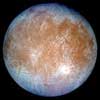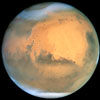|
Sunday:
February 16, 2003 | |
0720 GMT |
 |
Missions to Europa surface said needed for life search
Scientists have long considered Europa, the smallest of the four Galilean moons orbiting Jupiter, as a prime candidate for life outside Earth because it is one of the few places in the solar system where liquid water may be found. Any future Europa exploration should focus on the identification of sites where signs of past or present life can be found and studied, says Ron Greeley, an ASU geology professor.
 FULL STORY FULL STORY
 |  |

|
 |
Study shows how water may have flowed on Mars
NASA scientists have discovered how an intricate martian network of streams, rivers and lakes may have carried water across Mars. Using new three-dimensional data from the Mars Global Surveyor spacecraft and a powerful state-of-the-art computer code that 'models' overland water flow, scientists visualized the complex flow of martian water.
 FULL STORY FULL STORY
 |  |

|
 |
|
Saturday:
February 15, 2003 | |
0800 GMT |
 |
Goodbye Ariane 4: Finale flight for workhorse rocket
Arianespace closed out its venerable Ariane 4 rocket program Saturday with an early morning
vault into space that put a shining end to one of the most successful commercial launchers in the
history of the industry.
 FULL STORY FULL STORY
 MISSION STATUS CENTER MISSION STATUS CENTER
 |  |

|
 |
Entry flight director recalls Columbia's final minutes
For entry flight director Leroy Cain, struggling to make sense of unexpected telemetry from the shuttle Columbia and still hoping to regain radio contact, it was a moment of reluctant, dawning realization that a day he'd hoped would never come was finally there.
 FULL STORY FULL STORY
 |  |

|
 |

Video coverage for subscribers only:
 VIDEO: INSIDE MISSION CONTROL DURING COLUMBIA'S REENTRY QT VIDEO: INSIDE MISSION CONTROL DURING COLUMBIA'S REENTRY QT
 SUBSCRIBE NOW SUBSCRIBE NOW

|
|
Friday:
February 14, 2003 | |
0110 GMT |
 |
NASA unveils revised Columbia accident timeline
Just one minute and 24 seconds after reaching the region of maximum aerodynamic heating off the coast of California, telemetry from the shuttle Columbia shows the first sign of unusual heating in the ship's left wing main landing gear wheel well, according to a dramatic new accident timeline released Thursday by NASA.
 FULL STORY FULL STORY
 |  |

|
 |
'What-if' email explained; gear signal believed faulty
NASA managers say an engineer's email discussing a worst-case scenario based on the assumption a foam debris impact during the shuttle Columbia's launch did, in fact, seriously damage the ship's heat-shield tiles is an example of normal "what-ifing" and not an expression of real concern that somehow failed to reach upper management.
 FULL STORY FULL STORY
 |  |

|
 |
Ariane 4 delayed for third day by strong winds
For the third day running, high winds have forced Arianespace to cancel plans to launch the final Ariane 4 rocket. Once launched, the mission will place the Intelsat 907 communications satellite into Earth orbit.
 MISSION STATUS CENTER MISSION STATUS CENTER
 |  |

|
 |
|
Thursday:
February 13, 2003 | |
0320 GMT |
 |
Study shows how water may have flowed on Mars
NASA scientists have discovered how an intricate martian network of streams, rivers and lakes may have carried water across Mars. Using new three-dimensional data from the Mars Global Surveyor spacecraft and a powerful state-of-the-art computer code that 'models' overland water flow, scientists visualized the complex flow of martian water.
 FULL STORY FULL STORY
 |  |

|
 |
Rivers of gas could be part of 'missing' matter
An Ohio State University astronomer and her colleagues have detected a type of hot gas in space that could account for part of the "missing" matter in the universe. A gas cloud, one trillion times more massive than our sun and more than 150 times hotter, surrounds our local group of galaxies, the astronomers reported in the journal Nature.
 FULL STORY FULL STORY
 |  |

|
 |
Upper level winds delay Ariane 4 for a second day
Unfavorable high-altitude winds have forced Arianespace to scrub the launch of the last Ariane 4 rocket for a second straight day. The mission will place the Intelsat 907 communications satellite into Earth orbit.
 MISSION STATUS CENTER MISSION STATUS CENTER
 |  |

|
 |
|
Wednesday:
February 12, 2003 | |
0600 GMT |
 |
Investigation board vows openness, independence
The chairman of the independent Columbia Accident Investigation Board - AIB - said Tuesday the root cause of the Feb. 1 shuttle disaster may never be known, but he vowed to leave no stone unturned in a herculean effort to nail down exactly what triggered NASA's second shuttle disaster.
 FULL STORY FULL STORY
 AUDIO: FLIGHT DIRECTOR LOOP RELEASED AUDIO: FLIGHT DIRECTOR LOOP RELEASED
 |  |

|
 |
Station crew remembers fallen colleagues
On Saturday morning, Feb. 1, the three-man crew of the international space station was working through its 70th day in orbit, preparing for a daily planning session with flight controllers in Houston and Moscow. Instead of having a routine chat with the astronaut "CAPCOM" in mission control, Johnson Space Center Director Jefferson Howell, a retired Marine Corps general, came on the line.
 FULL STORY FULL STORY
 |  |

|
 |

Video coverage for subscribers only:
 VIDEO: EXPEDITION 6 IN-FLIGHT NEWS CONFERENCE QT VIDEO: EXPEDITION 6 IN-FLIGHT NEWS CONFERENCE QT
 SUBSCRIBE NOW SUBSCRIBE NOW

|
Winds keep final Ariane 4 rocket on the launch pad
Launch of the last Ariane 4 rocket has been postponed due to unfavorable high-altitude winds. Liftoff had been planned for 0700 GMT to deliver the Intelsat 907 communications satellite into Earth orbit. A new launch date has not been announced.
 MISSION STATUS CENTER MISSION STATUS CENTER
 |  |

|
 |
Age of universe refined
NASA has unveiled the sharpest picture ever taken of the infant universe, a landmark set of data showing when the very first stars "turned on" a surprisingly brief 200 million years after the big bang birth of the cosmos.
 FULL STORY FULL STORY
 |  |

|
 |

Video coverage for subscribers only:
 VIDEO: WATCH ENTIRE NASA NEWS CONFERENCE QT VIDEO: WATCH ENTIRE NASA NEWS CONFERENCE QT
 SUBSCRIBE NOW SUBSCRIBE NOW

|
|
Tuesday:
February 11, 2003 | |
0500 GMT |
 |
Part of Columbia's suspect left wing recovered
NASA engineers confirmed the recovery of debris from the shuttle Columbia's left wing Monday amid reports one of the orbiter's four general purpose flight computers - or some sort of avionics box - might have been located.
 FULL STORY FULL STORY
 |  |

|
 |
Hubble gives close-up view of the Dumbbell Nebula
An aging star's last hurrah is creating a flurry of glowing knots of gas that appear to be streaking through space in this close-up image of the Dumbbell Nebula, taken with NASA's Hubble Space Telescope.
 FULL STORY FULL STORY
 |  |

|
 |
Violent truth behind Sun's 'gentle giants' uncovered
Solar physicists have discovered new clues to understanding explosions on the Sun. Coronal mass ejections are violent explosions that can fling electrified gas with a mass greater than Mount Everest towards the Earth with destructive consequences for satellites.
 FULL STORY FULL STORY
 |  |

|
 |
Ariane 4 rocket to make last flight Wednesday
Marking the end of the road for one of the most successful commercial rockets in history, the final Ariane 4 rocket is due to launch early Wednesday morning from its South American spaceport. Liftoff is set for the opening of an hour-long window at 0700 GMT (2 a.m. EST).
 MISSION STATUS CENTER MISSION STATUS CENTER
 |  |

|
 |
|
Monday:
February 10, 2003 | |
0338 GMT |
 |
The timeline of shuttle Columbia's final re-entry
This timeline was compiled from telemetry data provided by shuttle program manager Ronald Dittemore and a transcription of the NASA-Select commentary loop from Houston. Dittemore cautions the telemetry timing may well change and readers should take the times listed with a grain of salt. They are strictly preliminary.
 SEE THE TIMELINE SEE THE TIMELINE
 |  |

|
 |
Shuttle chief explains Columbia's final minutes
Using detailed charts, the shuttle program manager shows where sensors are located in the shuttle's left wing either failed or recorded abnormal pressure or temperature readings.
 VIDEO: THE PRELIMINARY SEQUENCE VIDEO: THE PRELIMINARY SEQUENCE
 |  |

|
 |


 This exceptional chronicle of the historic Apollo 11 lunar landing mission features new digital transfers of film and television coverage unmatched by any other.
This exceptional chronicle of the historic Apollo 11 lunar landing mission features new digital transfers of film and television coverage unmatched by any other.